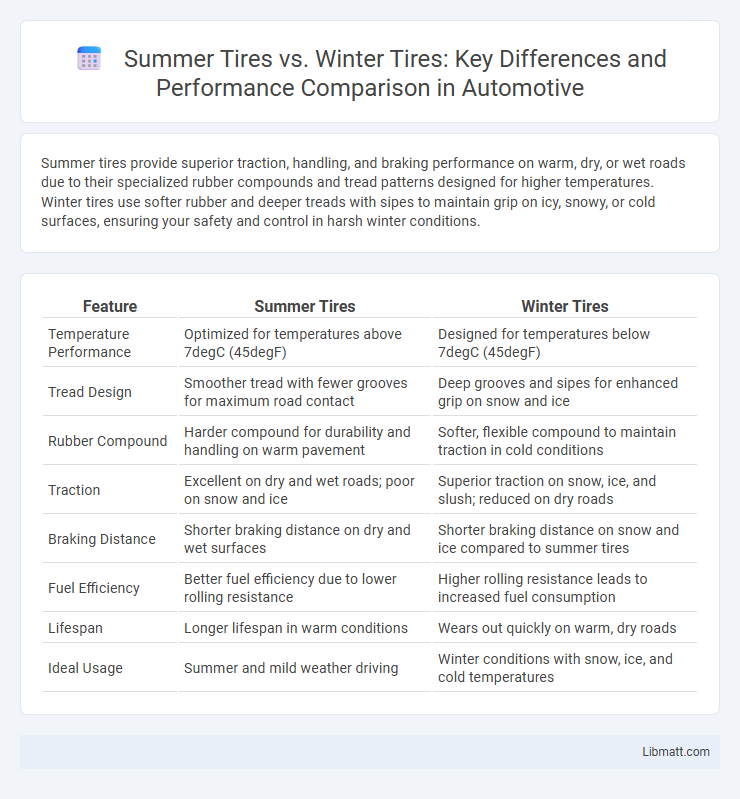Summer tires provide superior traction, handling, and braking performance on warm, dry, or wet roads due to their specialized rubber compounds and tread patterns designed for higher temperatures. Winter tires use softer rubber and deeper treads with sipes to maintain grip on icy, snowy, or cold surfaces, ensuring your safety and control in harsh winter conditions.
Table of Comparison
| Feature | Summer Tires | Winter Tires |
|---|---|---|
| Temperature Performance | Optimized for temperatures above 7degC (45degF) | Designed for temperatures below 7degC (45degF) |
| Tread Design | Smoother tread with fewer grooves for maximum road contact | Deep grooves and sipes for enhanced grip on snow and ice |
| Rubber Compound | Harder compound for durability and handling on warm pavement | Softer, flexible compound to maintain traction in cold conditions |
| Traction | Excellent on dry and wet roads; poor on snow and ice | Superior traction on snow, ice, and slush; reduced on dry roads |
| Braking Distance | Shorter braking distance on dry and wet surfaces | Shorter braking distance on snow and ice compared to summer tires |
| Fuel Efficiency | Better fuel efficiency due to lower rolling resistance | Higher rolling resistance leads to increased fuel consumption |
| Lifespan | Longer lifespan in warm conditions | Wears out quickly on warm, dry roads |
| Ideal Usage | Summer and mild weather driving | Winter conditions with snow, ice, and cold temperatures |
Introduction to Tire Types
Summer tires feature specialized rubber compounds and tread patterns designed for optimal performance on dry and wet roads in warm temperatures, offering enhanced grip and handling. Winter tires utilize softer rubber compounds and deeper, more aggressive tread designs to maintain traction on snow and ice, providing improved safety in freezing conditions. Choosing the right tire type according to seasonal weather ensures maximum vehicle control and tire longevity.
Key Differences Between Summer and Winter Tires
Summer tires feature specialized rubber compounds and tread patterns designed for optimal traction and performance on dry and wet roads at higher temperatures. Winter tires incorporate softer rubber and deep, aggressive tread designs with sipes to enhance grip on snow, ice, and cold pavement. The key differences in tread structure, rubber composition, and temperature range determine their effectiveness in handling seasonal driving conditions.
Performance in Warm Weather: Summer Tires
Summer tires provide superior performance in warm weather due to their specialized rubber compounds that remain flexible at higher temperatures, enhancing grip and handling on dry and wet roads. Their tread patterns are optimized for efficient water evacuation, reducing the risk of hydroplaning during summer rain. Compared to winter tires, summer tires offer better responsiveness and shorter braking distances in temperatures above 45degF (7degC).
Performance in Cold Weather: Winter Tires
Winter tires provide superior performance in cold weather due to their specialized rubber compounds that remain flexible at temperatures below 45degF (7degC), enhancing grip on icy and snowy surfaces. Their unique tread patterns are designed to channel snow and slush, reducing the risk of hydroplaning and improving traction. Compared to summer tires, winter tires significantly reduce braking distances and improve vehicle control in freezing conditions.
Tread Patterns and Rubber Compounds
Summer tires feature tread patterns designed for maximum contact with dry and wet roads, enhancing grip and handling in warm conditions, while their rubber compounds remain hard and stable to prevent excessive wear. Winter tires have deeper, more aggressive tread patterns with sipes that improve traction on snow and ice, along with softer rubber compounds that stay flexible in low temperatures to maintain grip. Choosing the right tire ensures Your vehicle performs optimally and safely throughout the changing seasons.
Safety and Handling Comparison
Summer tires provide superior grip and handling on warm, dry, and wet roads due to their specialized rubber compounds and tread patterns designed for higher temperatures. Winter tires feature deeper treads and softer rubber optimized for cold, icy, and snowy conditions, ensuring enhanced traction and shorter braking distances in winter weather. Choosing the right tires for the season is crucial for your safety and optimal vehicle control.
Fuel Efficiency: Summer vs Winter Tires
Summer tires offer superior fuel efficiency compared to winter tires due to their harder rubber compounds and optimized tread patterns that reduce rolling resistance on dry and wet roads. Winter tires, made with softer rubber and deeper treads, provide enhanced traction in snow and ice but increase rolling resistance, leading to higher fuel consumption. Choosing the appropriate tire seasonally can optimize fuel economy by balancing traction needs and rolling efficiency.
Longevity and Wear Factors
Summer tires offer enhanced durability on warm, dry roads due to their harder rubber compounds, which resist wear and extend tread life compared to winter tires. Winter tires feature softer rubber and aggressive tread patterns designed to maintain flexibility and grip in cold temperatures, but this results in faster wear when used on hot, dry pavement. Choosing the appropriate tire type for the season maximizes longevity and optimizes your vehicle's performance and safety.
When to Switch Your Tires
Switching from summer tires to winter tires should occur when temperatures consistently drop below 7degC (45degF), as winter tires provide better traction on cold, icy, or snowy roads. Summer tires lose flexibility in colder weather, compromising grip and safety, while winter tires are designed with specialized rubber compounds and tread patterns to maintain performance in winter conditions. Timely tire changes improve vehicle control and reduce the risk of accidents during seasonal transitions.
Choosing the Right Tires for Your Climate
Choosing the right tires for your climate ensures optimal vehicle performance and safety. Summer tires provide superior grip and handling on dry, warm roads with their specialized rubber compounds, while winter tires offer enhanced traction on snow and ice thanks to deeper treads and softer materials. Your tire selection should align with seasonal temperature changes to maintain control and reduce wear.
Summer tires vs Winter tires Infographic

 libmatt.com
libmatt.com